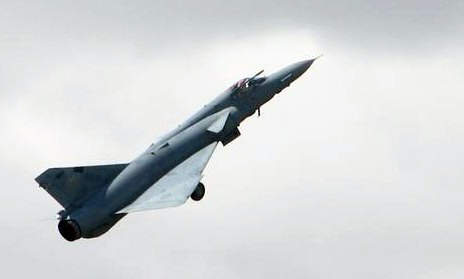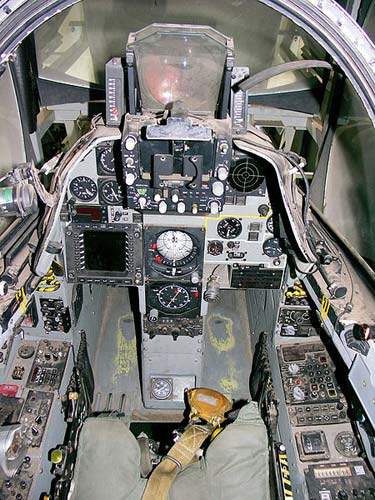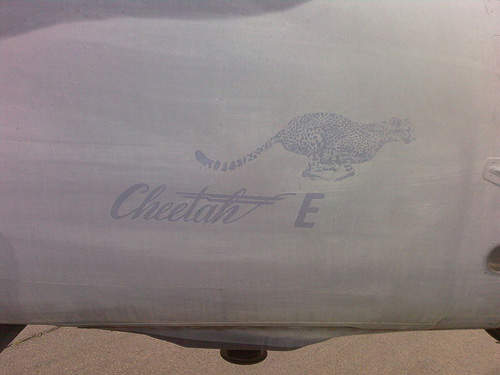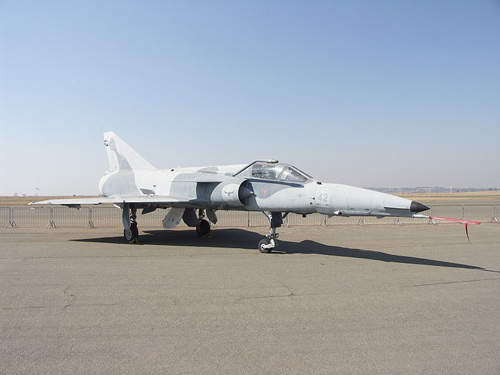The single-seat multirole fighter aircraft, the Atlas Cheetah, was manufactured by Denel Aviation Systems (formerly Atlas Aircraft Corporation) in South Africa. It was derived from the Dassault Mirage III aircraft.
The South African Air Force (SAAF) had been operating the Cheetah since 1986. In 2008, the cheetah series (a dual-seat Cheetah D, single-seat Cheetah E and C) was retired from SAAF’s service and replaced by 26 Saab JAS 39 Gripens (17C/9D).
Ecuadorian Air Force Cheetah C supersonic fighter jets
Denel Aviation partnered with Armscor, South Africa’s defence procurement, disposals, and research and development agency in September 2009 to lead the sale and upgrade of 12 of the SAAF’s Cheetah C supersonic fighters to the Ecuadorian Air Force (FAE). These Cheetahs were upgraded with new avionics and radar systems equivalent to those of Israel’s KFIR CE fighter aircraft.
The contract for supplying the Cheetahs to the Ecuadorian Air Force includes providing the renewable maintenance for five years. The delivery of the Cheetah aircraft will commence in December 2009. Initially, Ecuador budgeted $35m for the project, but the total cost is expected to increase.
The FAE team visited South Africa in April 2010 to examine the Cheetah fleet and undertake specific evaluation flights.
An agreement to conclude the deal was signed in December 2010. Under the contract, Denel Aviation will also provide maintenance, repair and overhaul (MRO) services for five years.
Denel Aviation will conduct maintenance and acceptance flight tests for the aircraft in South Africa and Ecuador.
Cheetah fighter jet variants
The Cheetah series has four variants: Cheetah C, D, E and R.
The Cheetah D aircraft has a second attack capability to deliver precision guided munition (PGMs) and is principally used for training the pilots of Cheetah C, which was launched later in 1992. The Cheetah D can handle a payload of 13,600kg and weighs 7,633kg when empty. Out of 13 Cheetah D, only ten have been upgraded with new Atar 09k50C-11 engine. The remaining aircraft were removed from service.
The Cheetah is also referred to as B, D or D2 based on the type of Mirage airframe. The Cheetah E is a multirole all-weather fighter model of Cheetah D aircraft. It was used as a standby interceptor with minimum two aircraft equipped with weapons providing round-the-clock alert status in case of attack. It was phased out of service in 1992 after the introduction of the Cheetah C aircraft.
The Cheetah C aircraft was developed by modernising the Cheetah E with state-of-the-art avionics and navigation suite, with a new pulse-Doppler multimode radar and an advanced EW suite. The Cheetah C is equipped with a data link for receiving updated versions of the helmet-mounted sight, HUD and improved HOTAS controls.
It is also fitted with a new nose, which accommodates more sophisticated electronics and radar systems. The Cheetah C aircraft can deliver precision-guided munitions (PGMs) varying from laser-guided bombs (LGBs), to GPS-guided weapons and TV-guided bombs. It also incorporates stand-off air-to-ground weapons.
The Cheetah R aircraft is primarily used as a reconnaissance model for testing and development of the Cheetah C. It is the only aircraft in which the in-flight refuelling probe and twin DEFA 30mm cannons were removed. The Mirage IIIR2Z, No.855 was chosen for this upgrade programme, which has new nose design and the same radar used in the Cheetah E.
Development
The United Nations Security Council Resolution 418, which halted the weapons delivery to South Africa forced the SAAF to upgrade the Mirage III with the latest Israeli technology and develop the state-of-the-art Cheetah fighter and strike aircraft, with the first Cheetah launched in July 1986.
The upgrades carried out by the Atlas Aircraft Corporation (now, Denel Aviation) and the Israel Aerospace Industries (IAI) in the Cheetah series included zero-hour Mirage airframe with canard surfaces and dogtooth wing extensions, provision for a bolt-on flight-refuelling probe mounted on the right air intake, a pair of additional weapons pylons beneath the engine air intakes, Martin Baker mk10 ejection seats and a dual-purpose Israeli radar. A new avionics suite and a licence-built powerful SNECMA Atar 9K-50 engine rated at 7,200kg are packed inside the extended nose of the D and C variants.
The avionics, radar, electronic warfare and self-protection systems, including a modern pulse doppler radar were also modernised inconjunction with the Cheetah C’s avionics.
The Cheetah series is also equipped with advanced avionics, a glass cockpit and HOTAS controls and utilises an array of sophisticated weapons. The Cheetah E aircraft is equipped with simple ranging radar which is used for ground attacks.
A twin computer flight control system to control the modern elevons, and strakes on the nose of the aircraft to improve high-angle attack performance were also included in the improvement process.
Denel Aviation in cooperation with IAI converted the 16 Mirage IIIEZs into Cheetah E aircraft, which show characteristics similar to Kfir C7. 11 two-seater Mirage IIIDZs and D2Zs were upgraded to the Cheetah D standard, which is equivalent to Kfir Tc7, and five additional Kfir and Mirage airframes supplied by IAI have also been modernised.
The dual-seat Cheetah D fighter aircraft took its maiden flight on 1 July 1986 with No 89 CFS, while the single-seat fighter aircraft, Cheetah E with No. 5 Squadron entered service in March 1988. In October 1992, the multirole fighter aircraft Cheetah C was developed as an upgraded version following the retirement of Cheetah E aircraft.
Avionics
The Cheetah E aircraft is equipped with lightweight Israeli Elta EL-2001 radar capable of tracking and targeting both air-to-air and air-to-ground combat. New navigation and weapons management systems, a self-defence suite, including missile and radar warning sensors, active jammers, and chaff-flare dispensers are also installed in the upgraded Cheetah E aircraft.
The chaff-flare dispensers were fitted in a fairing under the tail, an Elbit HUD, and a South African-built helmet mounted sight.
Weapons
The armaments commonly carried by the Cheetah C, D and E fighter aircraft include a 12.5kg practice bomb, a 120kg fragmentation bomb, a 120kg low-drag bomb, a 145kg bomb, a 250kg fragmentation bomb, a 460kg bomb, a 745 (Paveway) laser-guided bomb, a CB-470 cluster bomb, an mk81 250lb bomb, a mk82 500lb bomb and a Raptor 1 glide bomb (H-2). In addition, the Cheetah C is also equipped with a Vicon 18-601E bomb.
They also carry a DEFA 553 30mm cannon, guided booster and Taxan target drogue.
The Cheetah is also equipped with a darter: U-Darter, V3C Darter, V3S Snake (Rafael Python3) and V4 R-Darter.
Performance
Cheetah can climb at a rate of 45,950ft a minute. The ferry and combat ranges of the aircraft were 2,600km and 1,300km respectively. It has the capacity to fly at 2,350km/h. The service ceiling and wingspan of the Cheetah are 17,000m and 8.22m respectively, while the wing loading of the aircraft is 250kg/m².
Engines
The Cheetah C, D and E aircraft are equipped with a SNECMA Atar 09K50C engine. The engine has the capacity to provide 10,500lb (15,050lb a/b) thrust. Snecma, a part of the SAFRAN Group, is the manufacturer of the Cheetah’s engine.








